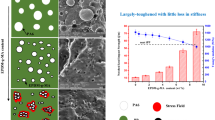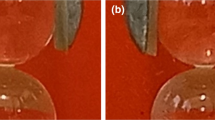Abstract
Interstitial component (IC), referring to the finer portion of asphalt mixture, is primarily responsible for tensile properties and thereby strongly affects mixture cracking performance. Whereas mixture tests are usually complex and labor-intensive, determination of fracture properties with a simpler test on the IC portion will add values in terms of ranking mixtures and predicting mixture fracture properties. An interstitial component direct tension (ICDT) test, which was derived from the dog bone direct tension test originally developed for asphalt mixtures, was applied to determine the fracture energy density (FED) of mixture IC portion. FED describes the damage tolerance before fracture occurs and it is also a component associated with crack propagation. Two methods of strain determination were evaluated including a digital image correlation (DIC) system and a predictive equation derived from finite element analysis with load-head displacement as input. ICDT tests were conducted on the IC portion of two sets of four mixtures, which had identical coarse aggregate structure. The DIC system yielded greater failure strain than those based on load-head displacement. However, the ratios between the two values for all mixtures were almost constant, supporting the use of the predictive equation as a surrogate. Moreover, IC FED ranked these mixtures in the same order as mixture FED and more importantly, an excellent correlation was observed between IC FED and mixture FED of these mixtures. In conclusion, the ICDT test can be used to determine the IC FED, which provides valuable insights regarding the effect of IC characteristics on mixture FED.












Similar content being viewed by others
References
Soenen H, De La Roche C, Redelius P (2004) Predict mix fatigue tests from binder fatigue properties, measured with a DSR. In: Proceedings of the 3rd Eurasphalt and Eurobitume Congress, Vienna, Austria, 12–14th May 2004
Bahia HU, Hanson DI, Zeng M, Zhai H, Khatri MA, Anderson RM (2001) Characterization of modified asphalt binders in Superpave mix design. NCHRP report 459, National Cooperative Highway Research Program, Transportation Research Board—National Research Council, Washington, DC
Johnson CM (2010) Estimating asphalt binder fatigue resistance using an accelerated test method. Ph.D. dissertation, University of Wisconsin-Madison, Madison, WI
Hintz C, Velasquez R, Johnson C, Bahia HU (2011) Modification and validation of the linear amplitude sweep test for binder fatigue specification. In: Transportation research record: Journal of the Transportation Research Board, No. 2207, Transportation Research Board of the National Academies, Washington, DC, pp 99–106
Andriescu A, Hesp SAM, Youtcheff JS (2004) Essential and plastic works of ductile fracture in asphalt binders. In Transportation Research Record: Journal of the Transportation Research Board, No. 1875, TRB, National Research Council, Washington, DC, pp 1–8
Niu T, Roque R, Lopp G (2014) Development of a binder fracture test to determine fracture energy properties. Road Mater Pavement Des 15(S1):219–238
Yan Y, Hernando D, Roque R (2017) Fracture tolerance of asphalt binder at intermediate temperatures. ASCE J Mater Civ Eng 29(9):04017108
AASHTO Provisional Standard TP101-14 (2012) Standard method of test for estimating damage tolerance of asphalt binders using the linear amplitude sweep. American Association of State Highway and Transportation Officials, Washington, DC
AASHTO Provisional Standard TP113-15 (2015) Standard method of test for determination of asphalt binder resistance to ductile failure using double-edge-notched (DENT) test. American Association of State Highway and Transportation Officials, Washington, DC
AASHTO Provisional Standard TP127-17 (2017) Standard method of test for determining the fracture energy density of asphalt binder using the binder fracture energy (BFE) test. American Association of State Highway and Transportation Officials, Washington, DC
Rowe G (2014) Interrelationships in rheology for asphalt binder specifications. In: Proceedings, 56th annual conference, Canadian Technical Asphalt Association, Winnipeg, MB, Canada. pp 457–483
Rowe G (2015) Linear visco-elastic binder properties and asphalt pavement cracking. In: Proceeding of the 11th conference on asphalt pavements for South Africa (CAPSA15), 16–19th August, Sun City, South Africa
Rowe GM, Sharrock MJ, Raposo S (2016) Cracking and linear visco elastic binder properties. In: Proceeding of the 8th RILEM international conference on mechanisms of cracking and debonding in pavements, Nantes, France, 7–9th June 2016
Widyatmoko I, Elliott RC, Heslop MW (2004) Mapping crack susceptibility of bituminous materials with binder durability. In: Proceeding of the 5th RILEM international conference on cracking in pavements-mitigation, Risk Assessment and Prevention, ENSIL, France, 5–8th May 2004
Rowe GM, Sharrock MJ (2016) Cracking of asphalt pavements and the development of specifications with rheological measurements. In: Proceeding of the 6th Eurasphalt and Eurobitume congress, Prague, Czech Republic, 1–3rd June 2016
Germann FP, Lytton RL (1979) Methodology for predicting the reflection cracking life of asphalt concrete overlays. Research report FHWA/TX-79/09 + 207-5, Texas Transportation Institute, Texas A&M University, College Station, TX
Zhou F, Scullion T (2003) Upgraded overlay tester and its application to characterize reflection cracking resistance of asphalt mixtures, FHWA/TX-04/0-4467-1, Texas Department of Transportation, Research and Technology Implementation Office, Austin, TX
Mohammad LN, Kim M, Elseifi M (2012) Characterization of asphalt mixtures’s fracture resistance using the semi-circular bending (SCB) test. In: Proceeding of the 7th RILEM international conference on cracking in pavements, Delft, Netherlands, 20–22nd June 2012
Roque R, Buttlar WG (1992) The development of a measurement and analysis system to accurately determine asphalt concrete properties using the indirect tensile mode. J Assoc Asph Paving Technol 61:304–332
Roque R, Birgisson B, Drakos C, Dietrich B (2004) Development and field evaluation of energy-based criteria for top-down cracking performance of hot-mix asphalt. J Assoc Asph Paving Technol 73:229–260
Tayebali AA, Deacon JA, Coplantz JS, Harvey JT, Monismith CL (1994) Fatigue response of asphalt-aggregate mixes—part I test method selection. Report SHRP-A-404, Asphalt Research Program, Strategic Highway Research Program, National Research Council, Washington, DC
Deacon JA, Tayebali AA, Coplantz JS, Finn FN, Monismith CL (1994) Fatigue response of asphalt—aggregate mixes: part III mix design and analysis. Report SHRP-A-404, Asphalt Research Program, Strategic Highway Research Program, National Research Council, Washington, DC
Lee HJ, Kim YR (1998) A Viscoelastic continuum damage model of asphalt concrete with healing. ASCE J Eng Mech 124(11):1224–1232
Daniel JS, Kim YR (2002) Development of a simplified fatigue test and analysis procedure using a viscoelastic continuum damage model. J Assoc Asph Paving Technol 71:619–650
Wagnoner MP, Buttlar WG, Paulino GH (2005) Disk-shaped compact tension test for asphalt concrete fracture. Exp Mech 45(3):270–277
Koh C, Lopp G, Roque R (2009) Development of a dog-bone direct tension test (DBDT) for asphalt concrete. In: Loizos A, Partl MN, Scarpas T, Al-Qadi IL (eds) Advanced testing and characterization of bituminous materials, two volume set. CRC Press, London, pp 585–596
Luo X, Luo R, Lytton RL (2013) Energy-based mechanistic approach to characterize crack growth of asphalt mixtures. J Mater Civ Eng Am Soc Civ Eng 25(9):1198–1208
Lytton R, Luo X, Luo R (2013) A mechanistic empirical model for top-down cracking of asphalt pavement layers, Interim report of project NCHRP 1-52, Texas A&M Transportation Institute, College Station, TX
Zhou F, Newcomb D, Gurganus C, Banihashemrad S, Sakhaeifar M, Park ES, Lytton RL (2016) Experimental design for field validation of laboratory tests to assess cracking resistance of asphalt mixtures. NCHRP Project. 9-57. National Cooperative Highway Research Program, the National Academies, Washington, DC
Di Benedetto H, Francken L (1997) Mechanical tests for bituminous materials, recent improvements and future prospects. In: Proceedings of the fifth international RILEM symposium on mechanical tests for bituminous materials, Lyon, France, 14–16th May 1997
Di Benedetto H, de La Roche C, Baaj H, Pronk AC, Lundstrom R (2004) Fatigue of bituminous mixes: different approaches and RILEM group contribution. In: Proceedings of the sixth international RILEM symposium on performance testing and evaluation of bituminous materials, Zurich, Switzerland, 11–16th April 2003
Buttlar WG, Chabot A, Dave EV, Petit C, Tebaldi G (2018) Mechanisms of cracking and debonding in asphalt and composite pavements: state-of-the-art of the RILEM TC241-MCD, RILEM state-of-the-art reports, vol 28. Springer, Switzerland
EN 12697-24 (2018) Bituminous mixtures—text methods part 24: resistance to fatigue. European Committee for Standardization, Brussels, Belgium
EN 12697-44 (2010) Bituminous mixtures—test method for hot mix asphalt part 44: crack propagation by semi-circular bending test. European Committee for Standardization, Brussels, Belgium
Haddock J, Kim S, Choubane B (1999) Accelerated pavement testing and gradation-based performance evaluation method. In: Transportation Research Record: Journal of the Transportation Research Board, no. 1681, TRB, National Research Council, Washington, DC, pp 59–68
Ruth BE, Roque R, Nukunya B (2002) Aggregate gradation characterization factors and their relationships to fracture energy and failure strain of asphalt mixtures. J Assoc Asph Paving Technol 71:310–344
Kim S, Roque R, Birgisson B (2006) Identification and assessment of the dominant aggregate size range (DASR) of asphalt mixture. J Assoc Asph Paving Technol 75:789–814
Guarin A (2009) Interstitial component characterization to evaluate asphalt mixture performance, Ph.D. dissertation, University of Florida, Gainesville, FL
Isola M (2014) Effect of interstitial volume characteristics on asphalt mixture durability and cracking performance, Ph.D. dissertation, University of Florida, Gainesville, FL
Bekoe MA (2015) Interstitial component characteristics and its effect on mixture properties, Ph.D. dissertation, University of Florida, Gainesville, FL
Koh C, Roque R (2010) Use of nonuniform stress-state tests to determine fracture energy of asphalt mixtures accurately. In: Transportation Research Record: Journal of the Transportation Research Board, no. 2181, TRB, National Research Council, Washington, DC, pp 55–66
Romeo E (2013) Two-dimensional digital image correlation for asphalt mixture characterization: interest and limitations. Road Mater Pavement Des 14(4):747–763
Yan Y, Roque R, Hernando D, Lopp G (2017) Development of a new methodology to effectively predict the fracture properties of RAP mixtures. Road Mater Pavement Des 17(S4):372–387
Mobasher BM, Mamlouk MS, Lin H-M (1997) Evaluation of crack propagation properties of asphalt mixtures. ASCE J Transp Eng 123:405–413
Li X, Marasteanu M (2004) Evaluation of the low temperature fracture resistance of asphalt mixtures using the semi-circular bend test. J Assoc Asph Paving Technol 73:401–426
Acknowledgements
The authors thank Cristian Cocconcelli, Karl R. Hallstrand and David Hernando for their valuable work during the development and evaluation of this interstitial component direct tension test.
Author information
Authors and Affiliations
Corresponding author
Ethics declarations
Conflict of interest
The authors declare that they have no conflict of interest.
Electronic supplementary material
Below is the link to the electronic supplementary material.
Rights and permissions
About this article
Cite this article
Yan, Y., Preti, F., Romeo, E. et al. Fracture energy density of interstitial component of asphalt mixtures. Mater Struct 51, 118 (2018). https://doi.org/10.1617/s11527-018-1251-7
Received:
Accepted:
Published:
DOI: https://doi.org/10.1617/s11527-018-1251-7




